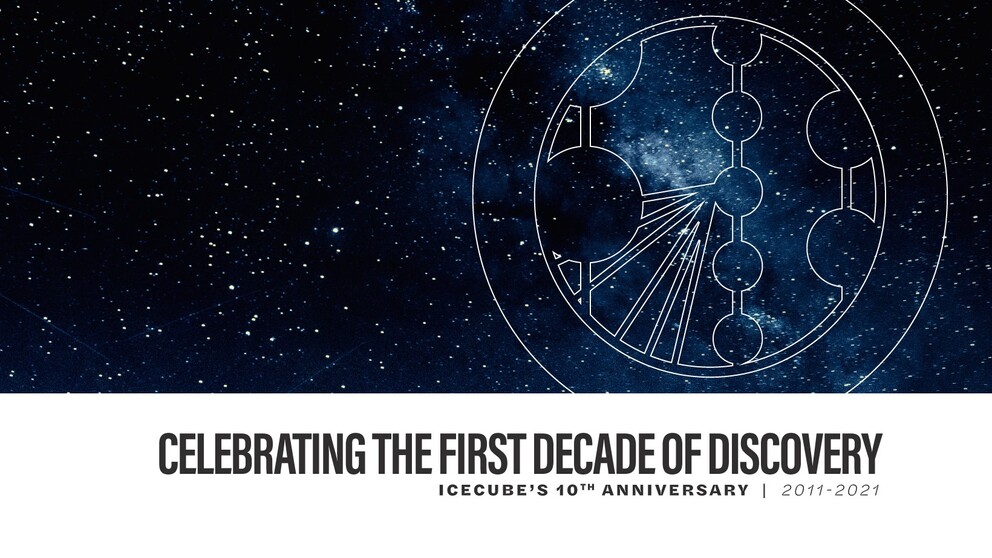
Celebrating IceCube Neutrino Observatory’s first decade of discovery
Posted on July 23, 2021Story originally published on Penn State News
UNIVERSITY PARK, Pa. — For the last 10 years, the unconventional IceCube Neutrino Observatory has been watching the cosmos, looking for signals of passing astrophysical neutrinos. These mysterious, tiny, extremely lightweight particles are created by some of the most energetic and distant phenomena in the cosmos. By identifying these neutrinos, the multi-institution IceCube collaboration — which includes several researchers at Penn State — can glimpse hidden parts of the universe.
The observatory itself is located at the South Pole, one of the coldest, driest, and most isolated places on Earth, and uses the Antarctic ice as an integral part of its detection system. During construction, crews drilled 86 holes nearly two-and-a-half kilometers deep and lowered a cable strung with 60 basketball-sized light detectors into each hole. The result was a hexagonal grid of sensors embedded in a cubic kilometer of ice about a mile below the surface of the Antarctic ice sheet. On Dec. 18, 2010, the 5,160th light sensor was deployed in the ice, completing the construction of the IceCube Neutrino Observatory.
“To detect neutrinos, we need a very large, kilometer-scale, detector made of optically clear material, and ice is an excellent option,” said Doug Cowen, professor of physics at Penn State and a charter member of the IceCube collaboration. “Because neutrinos travel through space without being deflected or absorbed, they have a unique ability to provide accurate information about where they came from in the distant universe, even billions of light-years away.”
Since then, the collaboration has observed even more astrophysical neutrinos and made strides to identify their potential sources. In 2017, the collaboration detected a neutrino that, for the first time, they were able to track back to its source — a blazar called TXS 0506+056. This marked the first evidence of a high-energy cosmic ray from an extragalactic source.
“Thanks to our combined efforts with the Astrophysical Multimessenger Observatory Network (AMON), an automatic alert was issued within seconds of the neutrino’s detection in 2017, allowing observatories around the world to follow-up the detection in various wavelengths of light,” said Cowen. “This allowed us to gain a more complete understanding of its source and provided an excellent example of the benefits of multimessenger astronomy.”
In addition to helping develop the cyberstructure for these real-time alerts, the Penn State team has played a leading role in the analysis of data from IceCube’s DeepCore low-energy extension. They are also interested in studying a particular type or “flavor” of neutrino called the tau neutrino, which carries a strong imprint of astrophysical origin.
The IceCube collaboration has grown to include more than 350 scientists from 53 institutions in 12 countries across five continents. Together, the collaboration has proven time and again the value of capturing perhaps the most elusive particles in the universe.
“The National Science Foundation took a dual gamble on IceCube related to the performance of the technology and the sensitivity of the instrument as a neutrino telescope,” said Francis Halzen, principal investigator of IceCube and professor at the University of Wisconsin–Madison, home of the Wisconsin IceCube Particle Astrophysics Center (WIPAC) where IceCube is headquartered. “The IceCube Collaboration has delivered a decade of data that continues to validate the high risk and high reward approach.”
The unusual instrument continues to expand its science reach, with leading results on neutrino properties, dark matter, cosmic rays, and fundamental physics. Though the pandemic has slightly altered the timeline, the National Science Foundation has provided funding for the next stage of the South Pole detector, the IceCube Upgrade, which will pave the way to the proposed larger, high-energy extension, IceCube-Gen2.
To join in the collaboration’s virtual anniversary celebrations, follow IceCube’s website and social media profiles — including on Facebook, Twitter, Instagram, and YouTube — and follow the hashtag #IceCube10. The collaboration will be sharing highlights from the past decade leading up to their fall collaboration meeting in September.
The IceCube Neutrino Observatory is funded primarily by the National Science Foundation and is headquartered at the Wisconsin IceCube Particle Astrophysics Center, a research center of UW–Madison in the United States. AMON has been funded by the National Science Foundation and the Penn State Institute for Gravitation and the Cosmos. Initial development of the network was supported by the Penn State Office of the Senior Vice President for Research and the Eberly College of Science.
Share
Related Posts
- Professor receives NSF grant to model cell disorder in heart
- Featured Researcher: Nick Tusay
- Multi-institutional team to use AI to evaluate social, behavioral science claims
- NSF invests in cyberinfrastructure institute to harness cosmic data
- Center for Immersive Experiences set to debut, serving researchers and students
- Distant Suns, Distant Worlds
- CyberScience Seminar: Researcher to discuss how AI can help people avoid adverse drug interactions
- AI could offer warnings about serious side effects of drug-drug interactions
- Taking RTKI drugs during radiotherapy may not aid survival, worsens side effects
- Cost-effective cloud research computing options now available for researchers
- Costs of natural disasters are increasing at the high end
- Model helps choose wind farm locations, predicts output
- Virus may jump species through ‘rock-and-roll’ motion with receptors
- Researchers seek to revolutionize catalyst design with machine learning
- Resilient Resumes team places third in Nittany AI Challenge
- ‘AI in Action’: Machine learning may help scientists explore deep sleep
- Clickbait Secrets Exposed! Humans and AI team up to improve clickbait detection
- Focusing computational power for more accurate, efficient weather forecasts
- How many Earth-like planets are around sun-like stars?
- SMH! Brains trained on e-devices may struggle to understand scientific info
- Whole genome sequencing may help officials get a handle on disease outbreaks
- New tool could reduce security analysts’ workloads by automating data triage
- Careful analysis of volcano’s plumbing system may give tips on pending eruptions
- Reducing farm greenhouse gas emissions may plant the seed for a cooler planet
- Using artificial intelligence to detect discrimination
- Four ways scholars say we can cut the chances of nasty satellite data surprises
- Game theory shows why stigmatization may not make sense in modern society
- Older adults can serve communities as engines of everyday innovation
- Pig-Pen effect: Mixing skin oil and ozone can produce a personal pollution cloud
- Researchers find genes that could help create more resilient chickens
- Despite dire predictions, levels of social support remain steady in the U.S.
- For many, friends and family, not doctors, serve as a gateway to opioid misuse
- New algorithm may help people store more pictures, share videos faster
- Head named for Ken and Mary Alice Lindquist Department of Nuclear Engineering
- Scientific evidence boosts action for activists, decreases action for scientists
- People explore options, then selectively represent good options to make difficult decisions
- Map reveals that lynching extended far beyond the deep South
- Gravitational forces in protoplanetary disks push super-Earths close to stars
- Supercomputer cluster donation helps turn high school class into climate science research lab
- Believing machines can out-do people may fuel acceptance of self-driving cars
- People more likely to trust machines than humans with their private info
- IBM donates system to Penn State to advance AI research
- ICS Seed Grants to power projects that use AI, machine learning for common good
- Penn State Berks team advances to MVP Phase of Nittany AI Challenge
- Creepy computers or people partners? Working to make AI that enhances humanity
- Sky is clearing for using AI to probe weather variability
- ‘AI will see you now’: Panel to discuss the AI revolution in health and medicine
- Privacy law scholars must address potential for nasty satellite data surprises
- Researchers take aim at hackers trying to attack high-value AI models
- Girls, economically disadvantaged less likely to get parental urging to study computers
- Seed grants awarded to projects using Twitter data
- Researchers find features that shape mechanical force during protein synthesis
- A peek at living room decor suggests how decorations vary around the world
- Interactive websites may cause antismoking messages to backfire
- Changing how government assesses risk may ease fallout from extreme financial events
- Penn State’s Leadership in AI Research
- Symposium at U.S. Capitol seeks solutions to election security
- Using social media to solve social problems- study funded by ICS seed grant

